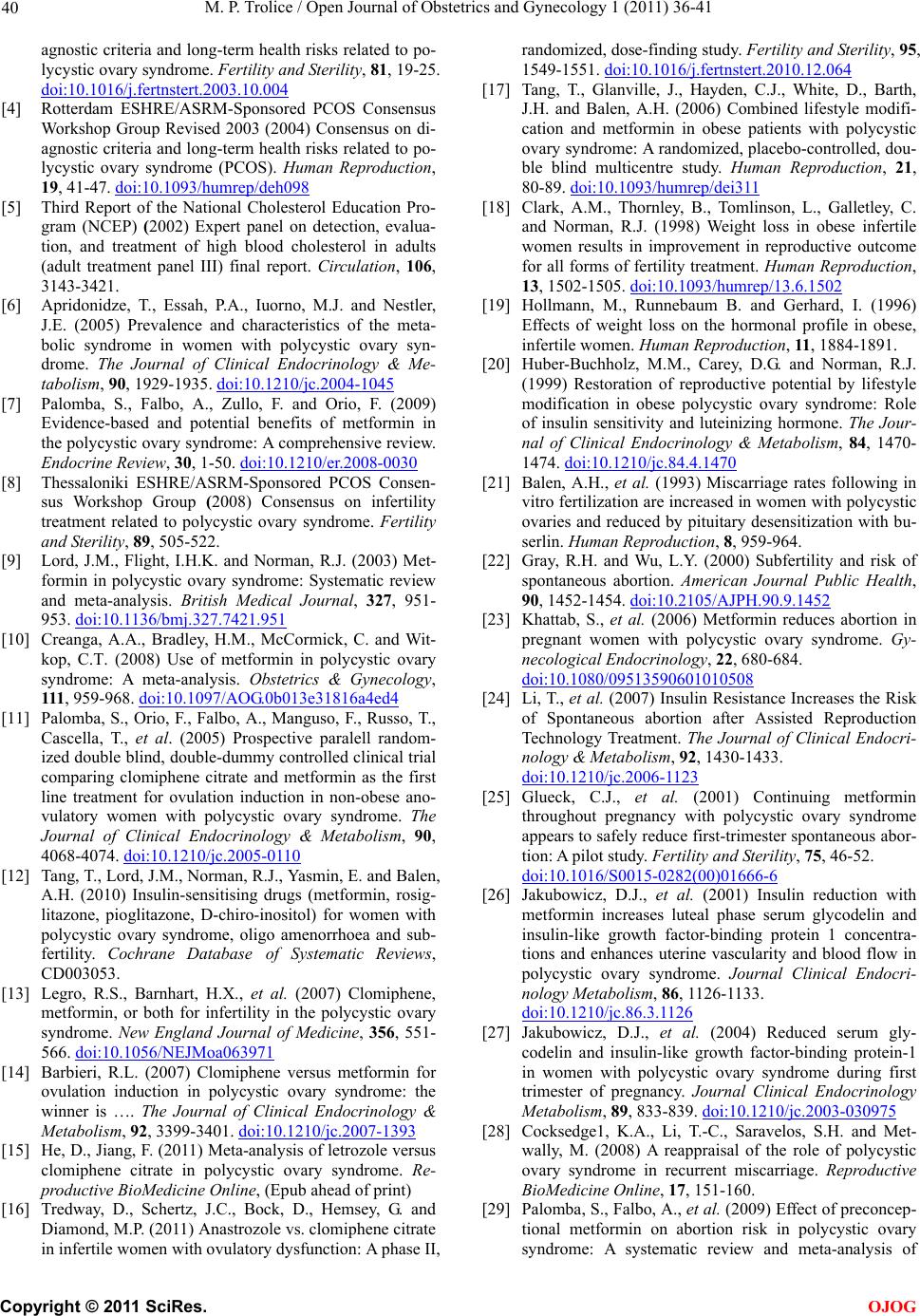
M. P. Trolice / Open Journal of Obstetrics and Gynecology 1 (2011) 36-41
40
agnostic criteria and long-term health risks related to po-
lycystic ovary syndrome. Fertility and Sterility, 81, 19-25.
doi:10.1016/j.fertnstert.2003.10.004
[4] Rotterdam ESHRE/ASRM-Sponsored PCOS Consensus
Workshop Group Revised 2003 (2004) Consensus on di-
agnostic criteria and long-term health risks related to po-
lycystic ovary syndrome (PCOS). Human Reproduction,
19, 41-47. doi:10.1093/humrep/deh098
[5] Third Report of the National Cholesterol Education Pro-
gram (NCEP) (2002) Expert panel on detection, evalua-
tion, and treatment of high blood cholesterol in adults
(adult treatment panel III) final report. Circulation, 106,
3143-3421.
[6] Apridonidze, T., Essah, P.A., Iuorno, M.J. and Nestler,
J.E. (2005) Prevalence and characteristics of the meta-
bolic syndrome in women with polycystic ovary syn-
drome. The Journal of Clinical Endocrinology & Me-
tabolism, 90, 1929-1935. doi:10.1210/jc.2004-1045
[7] Palomba, S., Falbo, A., Zullo, F. and Orio, F. (2009)
Evidence-based and potential benefits of metformin in
the polycystic ovary syndrome: A comprehensive review.
Endocrine Review, 30, 1-50. doi:10.1210/er.2008-0030
[8] Thessaloniki ESHRE/ASRM-Sponsored PCOS Consen-
sus Workshop Group (2008) Consensus on infertility
treatment related to polycystic ovary syndrome. Fertility
and Sterility, 89, 505-522.
[9] Lord, J.M., Flight, I.H.K. and Norman, R.J. (2003) Met-
formin in polycystic ovary syndrome: Systematic review
and meta-analysis. British Medical Journal, 327, 951-
953. doi:10.1136/bmj.327.7421.951
[10] Creanga, A.A., Bradley, H.M., McCormick, C. and Wit-
kop, C.T. (2008) Use of metformin in polycystic ovary
syndrome: A meta-analysis. Obstetrics & Gynecology,
111, 959-968. doi:10.1097/AOG.0b013e31816a4ed4
[11] Palomba, S., Orio, F., Falbo, A., Manguso, F., Russo, T.,
Cascella, T., et al. (2005) Prospective paralell random-
ized double blind, double-dummy controlled clinical trial
comparing clomiphene citrate and metformin as the first
line treatment for ovulation induction in non-obese ano-
vulatory women with polycystic ovary syndrome. The
Journal of Clinical Endocrinology & Metabolism, 90,
4068-4074. doi:10.1210/jc.2005-0110
[12] Tang, T., Lord, J.M., Norman, R.J., Yasmin, E. and Balen,
A.H. (2010) Insulin-sensitising drugs (metformin, rosig-
litazone, pioglitazone, D-chiro-inositol) for women with
polycystic ovary syndrome, oligo amenorrhoea and sub-
fertility. Cochrane Database of Systematic Reviews,
CD003053.
[13] Legro, R.S., Barnhart, H.X., et al. (2007) Clomiphene,
metformin, or both for infertility in the polycystic ovary
syndrome. New England Journal of Medicine, 35 6, 551-
566. doi:10.1056/NEJMoa063971
[14] Barbieri, R.L. (2007) Clomiphene versus metformin for
ovulation induction in polycystic ovary syndrome: the
winner is …. The Journal of Clinical Endocrinology &
Metabolism, 92, 3399-3401. doi:10.1210/jc.2007-1393
[15] He, D., Jiang, F. (2011) Meta-analysis of letrozole versus
clomiphene citrate in polycystic ovary syndrome. Re-
productive BioMedicine Online, (Epub ahead of print)
[16] Tredway, D., Schertz, J.C., Bock, D., Hemsey, G. and
Diamond, M.P. (2011) Anastrozole vs. clomiphene citrate
in infertile women with ovulatory dysfunction: A phase II,
randomized, dose-finding study. Fertility and Sterility, 95,
1549-1551. doi:10.1016/j.fertnstert.2010.12.064
[17] Tang, T., Glanville, J., Hayden, C.J., White, D., Barth,
J.H. and Balen, A.H. (2006) Combined lifestyle modifi-
cation and metformin in obese patients with polycystic
ovary syndrome: A randomized, placebo-controlled, dou-
ble blind multicentre study. Human Reproduction, 21,
80-89. doi:10.1093/humrep/dei311
[18] Clark, A.M., Thornley, B., Tomlinson, L., Galletley, C.
and Norman, R.J. (1998) Weight loss in obese infertile
women results in improvement in reproductive outcome
for all forms of fertility treatment. Human Reproduction,
13, 1502-1505. doi:10.1093/humrep/13.6.1502
[19] Hollmann, M., Runnebaum B. and Gerhard, I. (1996)
Effects of weight loss on the hormonal profile in obese,
infertile women. Human Reproduction, 11, 1884-1891.
[20] Huber-Buchholz, M.M., Carey, D.G. and Norman, R.J.
(1999) Restoration of reproductive potential by lifestyle
modification in obese polycystic ovary syndrome: Role
of insulin sensitivity and luteinizing hormone. The Jour-
nal of Clinical Endocrinology & Metabolism, 84, 1470-
1474. doi:10.1210/jc.84.4.1470
[21] Balen, A.H., et al. (1993) Miscarriage rates following in
vitro fertilization are increased in women with polycystic
ovaries and reduced by pituitary desensitization with bu-
serlin. Human Reproduction, 8, 959-964.
[22] Gray, R.H. and Wu, L.Y. (2000) Subfertility and risk of
spontaneous abortion. American Journal Public Health,
90, 1452-1454. doi:10.2105/AJPH.90.9.1452
[23] Khattab, S., et al. (2006) Metformin reduces abortion in
pregnant women with polycystic ovary syndrome. Gy-
necological Endocrinology, 22, 680-684.
doi:10.1080/09513590601010508
[24] Li, T., et al. (2007) Insulin Resistance Increases the Risk
of Spontaneous abortion after Assisted Reproduction
Technology Treatment. The Journal of Clinical Endocri-
nology & Metabolism, 92, 1430-1433.
doi:10.1210/jc.2006-1123
[25] Glueck, C.J., et al. (2001) Continuing metformin
throughout pregnancy with polycystic ovary syndrome
appears to safely reduce first-trimester spontaneous abor-
tion: A pilot study. Fertility and Sterility, 75, 46-52.
doi:10.1016/S0015-0282(00)01666-6
[26] Jakubowicz, D.J., et al. (2001) Insulin reduction with
metformin increases luteal phase serum glycodelin and
insulin-like growth factor-binding protein 1 concentra-
tions and enhances uterine vascularity and blood flow in
polycystic ovary syndrome. Journal Clinical Endocri-
nology Metabolism, 86, 1126-1133.
doi:10.1210/jc.86.3.1126
[27] Jakubowicz, D.J., et al. (2004) Reduced serum gly-
codelin and insulin-like growth factor-binding protein-1
in women with polycystic ovary syndrome during first
trimester of pregnancy. Journal Clinical Endocrinology
Metabolism, 89, 833-839. doi:10.1210/jc.2003-030975
[28] Cocksedge1, K.A., Li, T.-C., Saravelos, S.H. and Met-
wally, M. (2008) A reappraisal of the role of polycystic
ovary syndrome in recurrent miscarriage. Reproductive
BioMedicine Online, 17, 151-160.
[29] Palomba, S., Falbo, A., et al. (2009) Effect of preconcep-
tional metformin on abortion risk in polycystic ovary
syndrome: A systematic review and meta-analysis of
C
opyright © 2011 SciRes. OJOG